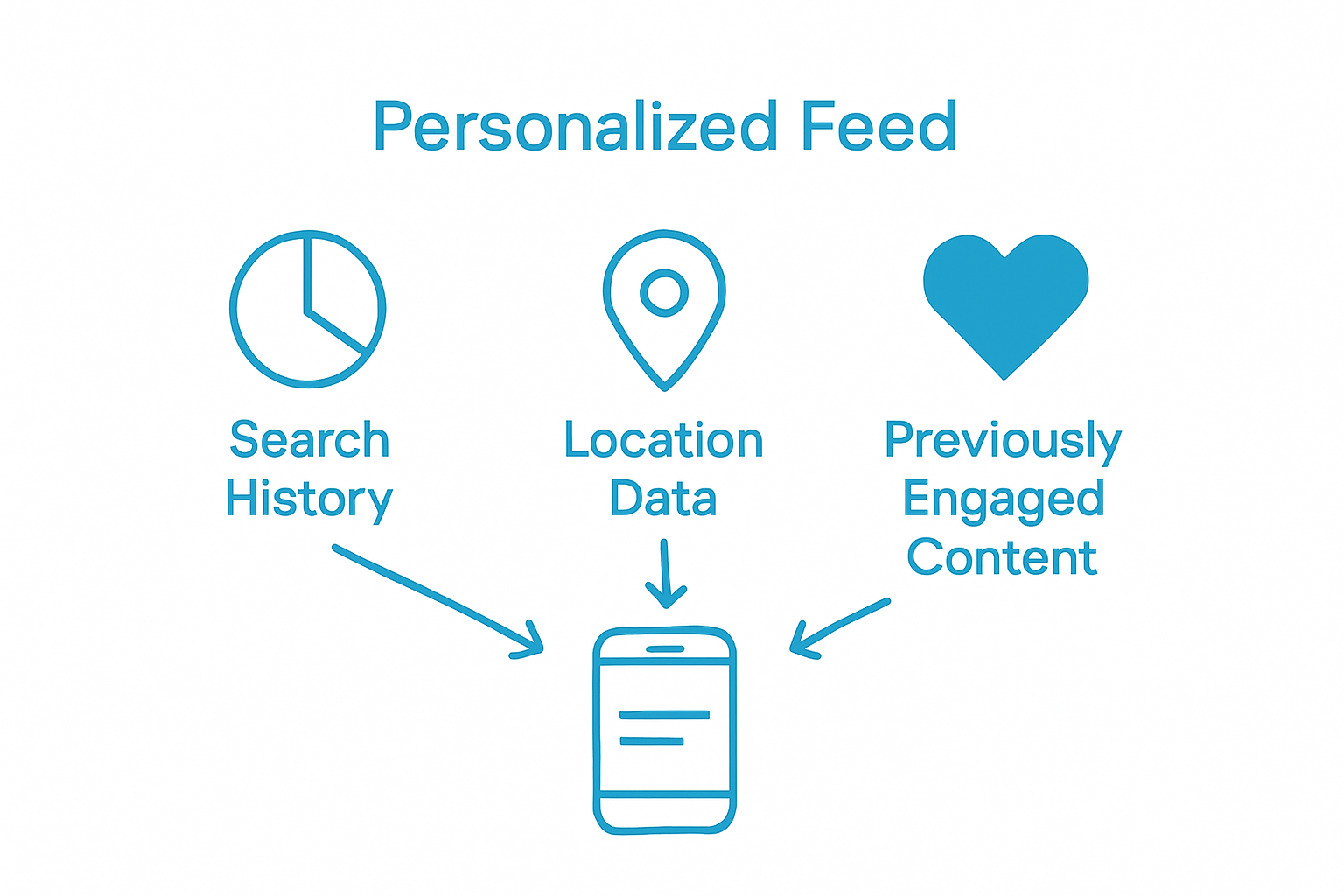Google Discover is changing the way people stumble upon fresh information on their phones every day. Surprise. Users are not typing in any searches but still get a feed designed just for them using their habits and interests. More than 800 million people now see these tailored recommendations and that changes everything for content creators looking to catch new eyes before anyone even opens a search bar.
Table of Contents
- What Is Google Discover And How Does It Function?
- The Importance Of Optimizing For Google Discover
- Key Concepts In Google Discover Optimization
- Strategies For Enhancing Content Visibility On Google Discover
Quick Summary
| Takeaway | Explanation |
|---|---|
| Google Discover personalizes content delivery | It uses algorithms to tailor recommendations based on user interests without the need for search queries. |
| Optimization increases audience reach | Content creators can leverage Google Discover to attract viewers before they actively search for related topics. |
| Focus on content quality and relevance | High engagement indicators, such as clicks and shares, are essential for content to be prioritized within Discover. |
| Technical requirements must be met | Content should feature quality visuals, be mobile-responsive, and load quickly for visibility on the platform. |
| Stay current with trending topics | Addressing timely subjects improves the likelihood of being featured on Google Discover, enhancing user engagement. |
What is Google Discover and How Does It Function?
Google Discover represents a personalized content recommendation platform that transforms how users consume digital information without actively searching. Unlike traditional search engines, this mobile feed dynamically presents content tailored to individual interests and preferences.
The Core Mechanism of Personalization
At its heart, Google Discover leverages advanced machine learning algorithms and the extensive Google Knowledge Graph to understand user preferences. The platform analyzes multiple data points to curate a unique content stream, including:
- Search history
- Browser activity
- Location data
- Device interactions
- Previously engaged content types
Understanding Content Selection and Ranking
The platform does not simply present random articles. Instead, it employs sophisticated ranking mechanisms that prioritize content relevance and user engagement. Google Discover evaluates content based on several critical factors:
- Topical Relevance: How closely content matches user interests
- Content Quality: Assessing credibility and information depth
- Visual Appeal: Preference for visually rich and engaging content
- Recency: Balancing current trending topics with evergreen information
Users encounter a continuous stream of articles, videos, and images across diverse categories without manually initiating a search. This proactive content discovery approach represents a significant shift from traditional search paradigms, offering a more intuitive and personalized information consumption experience.
Here, we compare key factors that influence content performance on Google Discover, highlighting the different ways each aspect contributes to visibility and engagement.
| Factor | Role in Discover Optimization | Example Impact |
|---|---|---|
| Topical Relevance | Aligns content with user interests | Increases chance of being recommended |
| Content Quality | Establishes credibility and informational depth | Drives higher engagement and trust |
| Visual Appeal | Attracts user attention in the feed | Improves click-through rates |
| Recency | Balances current trends with timeless topics | Boosts visibility for timely content |
| Engagement Metrics | Measures actual user interactions (clicks, shares) | Prioritizes high-performing content |

The Importance of Optimizing for Google Discover
Optimizing for Google Discover has become a critical strategy for digital content creators seeking to expand their audience reach and engagement. Unlike traditional search results, Discover provides an unprecedented opportunity to connect with users before they actively search for content.
Traffic Generation and Audience Expansion
Search Engine Journal highlights that Google Discover can generate substantial organic traffic, often surpassing traditional search results. This platform offers content creators a unique channel to:
- Reach users with personalized content recommendations
- Bypass traditional search query limitations
- Increase visibility across diverse audience segments
- Enhance brand awareness without direct user search intent
Strategic Content Performance Benefits
Successful optimization for Google Discover goes beyond mere visibility. It represents a strategic approach to content distribution that leverages machine learning and user behavior analysis. Content that performs well on Discover typically demonstrates:
- High Engagement Metrics: Content receiving more clicks, shares, and interactions
- Contextual Relevance: Material closely aligned with user interests
- Multimedia Rich Presentations: Visual content with compelling imagery
By understanding and implementing Google Discover optimization techniques, content creators can significantly enhance their digital presence. Learn more about mobile content strategies that complement Discover optimization and drive meaningful audience connections.
The potential for organic growth through Google Discover is substantial, making it an essential component of modern digital content strategies.
 Publishers who invest time in understanding and adapting to this platform can unlock new audience engagement opportunities and drive significant traffic to their digital properties.
Publishers who invest time in understanding and adapting to this platform can unlock new audience engagement opportunities and drive significant traffic to their digital properties.
Key Concepts in Google Discover Optimization
Effective Google Discover optimization requires a nuanced understanding of content design, user engagement signals, and platform-specific ranking mechanisms. Content creators must move beyond traditional SEO strategies to craft experiences that resonate with Google’s intelligent recommendation system.
Content Relevance and User Interest Signals
At the core of Google Discover optimization lies the ability to create contextually relevant content that aligns with user interests. Understanding how search algorithms work provides critical insights into how platforms like Discover evaluate and prioritize content. Key user interest signals include:
- Consistent topical expertise
- High engagement rates
- Diverse content formats
- Timely and trending subject matter
- Personal user preference patterns
Technical Content Requirements
Google Discover imposes specific technical requirements that content must meet to be eligible for recommendation. These technical considerations go beyond traditional SEO optimization and include:
The following table summarizes the main technical requirements your content must meet for optimal visibility on Google Discover and how each contributes to performance.
| Technical Requirement | Description |
|---|---|
| High Quality Visual Elements | Use clear, compelling images that enhance the content |
| Mobile Responsiveness | Ensure content displays seamlessly across mobile devices |
| Fast Loading Speed | Minimize page load times for better user experience |
| Structured Data Implementation | Use schema markup and clear metadata to aid content discoverability |
- High Quality Visual Elements: Clear, compelling images that complement written content
- Mobile Responsiveness: Seamless display across different mobile devices
- Fast Loading Speed: Minimal page load times
- Structured Data Implementation: Clear metadata and schema markup
Successful optimization requires a holistic approach that balances technical excellence with compelling, user-focused content. By understanding these intricate mechanisms, content creators can significantly enhance their visibility and engagement on this dynamic platform.
Strategies for Enhancing Content Visibility on Google Discover
Successful content visibility on Google Discover demands a sophisticated approach that combines strategic content creation, technical optimization, and deep understanding of user engagement dynamics. Creators must develop nuanced strategies that align with the platform’s intelligent recommendation algorithms.
Content Quality and Expertise Signals
Establishing topical authority is crucial for Google Discover visibility. Content promotion strategies play a significant role in demonstrating expertise and relevance. Content creators should focus on:
- Developing comprehensive, in depth content
- Maintaining consistent subject matter expertise
- Creating authoritative content that provides unique insights
- Demonstrating expertise through comprehensive coverage
- Building a robust content ecosystem around specific topics
Engagement and Performance Optimization
Google Discover prioritizes content that demonstrates strong user engagement and performance metrics. Key optimization strategies include:
- High Quality Visual Content: Incorporating compelling, original imagery
- Interactive Elements: Including engaging multimedia components
- Timely and Trending Topics: Addressing current conversations
- User Experience Design: Creating easily digestible, mobile friendly content
Successful optimization requires a holistic approach that balances technical excellence with genuine user value. By understanding and implementing these sophisticated strategies, content creators can significantly improve their visibility and engagement potential on Google Discover.
Struggling to Get Noticed on Google Discover? Here’s Your Solution
If you feel your high-quality content is getting buried and you are frustrated by inconsistent visibility on Google Discover, you are not alone. Many content creators and SEO professionals face this same struggle as they battle with issues like content cannibalization, missed optimization signals, and unpredictable engagement. In the article, you learned how Google Discover values relevance, authority, and engagement. But when your pages compete for similar topics or keywords, your efforts can quickly lose impact and your audience can drift to competitors.
Do you want to take control of your content performance and maximize your reach on Google Discover right now? Use the #1 Keyword Cannibalization Tool trusted by top SEO consultants and agencies. Identify overlap, sharpen your content strategy, and ensure each page stands out as an authority to Google’s algorithms. Start optimizing for the moments that matter and get your content into the Discover feed without hesitation. Visit RankAligner and discover how you can transform confusion into clicks today.
Frequently Asked Questions
What is Google Discover and how does it work?
Google Discover is a personalized content recommendation platform that presents a continuous stream of articles, videos, and images tailored to user interests without the need for an active search. It utilizes machine learning algorithms to curate content based on various data points such as search history, browser activity, and user preferences.
How can I optimize my content for Google Discover?
To optimize for Google Discover, focus on creating high-quality, contextually relevant content that aligns with user interests. Important factors include using compelling visual elements, ensuring mobile responsiveness, and implementing structured data to enhance content discoverability.
What types of content perform well on Google Discover?
Content that demonstrates high engagement metrics, topical relevance, and visual appeal tends to perform well on Google Discover. Combining multimedia elements with timely and trending topics can also increase visibility and interaction rates.
What technical requirements should my content meet for Google Discover?
To be eligible for Google Discover recommendations, content must have high-quality visual elements, be mobile-friendly, load quickly, and include structured data and metadata. Meeting these technical specifications is crucial for optimizing performance on the platform.

